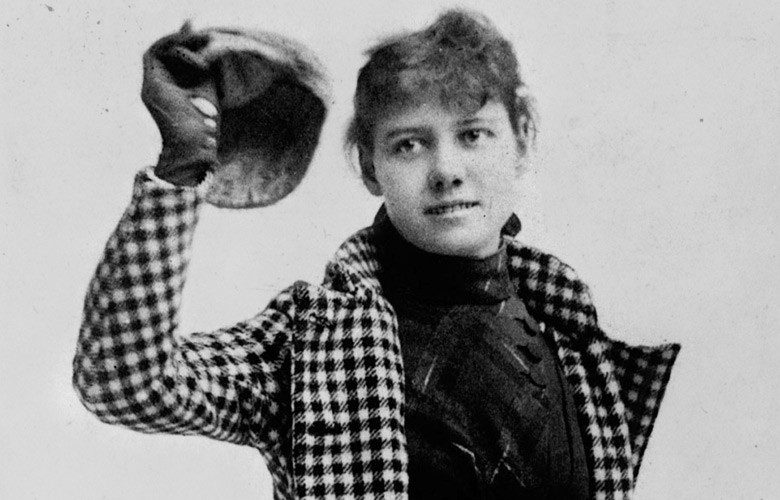by
_____
A sculpture installation opens today in New York City to honor the intrepid globe-trotting journalist and activist Nellie Bly.
Created by artist Amanda Matthews, the multi-part sculpture sits on the northern tip of Roosevelt Island, not far from the the remains of the Blackwell Island Asylum. That’s where where Elizabeth Jane Cochran — her pen name was Nellie Bly — went undercover as a patient.
The series she wrote, later published as a book Ten Days in a Mad-House, caused a sensation, led to institutional reforms, and brought her Nellie Bly fame as a crusading reformer.
“I have never had but one desire, and that was to benefit humanity,” Bly famously said.
And her journalism certainly fulfilled that mission. But what’s often unappreciated about her is Nellie Bly’s public voice. She was an early example of a woman who understood the economic value of her public speaking, and turned that into a moneymaking venture.
Bly was an early example of a woman who understood the market value of her public speaking, and turned that into a moneymaking venture.
Nellie Bly began her writing life in response to a newspaper column, “What Girls Are Good For,” in the Pittsburgh Dispatch. The message was that girls were good for for giving birth and keeping house. Her sharply-worded responses landed her a journalism job.
She wrote investigative articles on the experiences of female factory workers. She became a foreign correspondent in Mexico, reporting on the lives and customs of the Mexican people. She went undercover in the New York “insane asylum and turned that experience into a series of newspaper articles in the New York World, then a book, Ten Days in a Mad-House.
But in the end, journalism wasn’t enough for Nellie Bly— because it didn’t pay well.
“I have never had but one desire, and that was to benefit humanity,” Bly famously said — and her journalism fulfilled that mission. But for Bly, journalism wasn’t enough.
In 1889, Nellie Bly made a remarkable, publicity-generating, record-breaking trip around the world. Her goal was to emulate the journey of Jules Verne’s fictional character Phileas Fogg, in Around the World in Eighty Days.
Just over seventy-two days after her departure from Hoboken, New Jersey, Nellie Bly was back in New York City, making headlines around the world and giving press interviews about her “globe girdling” tour.
Then she launched a speaking tour. Her manager was J. M. Hill, owner of the Union Square Theater in New York City. He arranged a two month tour, in February and March 1890. During those eight weeks, Nellie Bly delivered 43 lectures about her world journey.
Typically she would speak for an hour and a half to “immense crowds who were anxious to see and hear her,” according to an account in the Harrisburg Daily Independent.
She launched a speaking tour about her “globe girdling tour.” Over the following two month, in February and March 1890, she delivered 43 lectures.
It was a lucrative trip. According to newspaper reports, the box receipts were as much as $1,400 an evening, equal to $43,000 today. As she pointed out in one interview, that was more money than she’d made in a dozen years as a newspaper reporter.
“I don’t call it lecturing, I simply talk,” she told the Lexington Herald-Leader in March.
“I can’t say that I like lecturing very well. There’s lots of hard work and discomfort in the constant traveling about and talking every night. But there is money in it, and money is exactly what I am after.”
“I have no hesitancy in saying that my greatest aim in life is to make money, and I am succeeding in a way I would not have dreamed of a very few years back. “
Bly also announced in interviews she was done being a journalist. “I have severed my connections with all papers,” she said.
She then took a lucrative job writing serial novels. She did briefly return to reporting for the New York World. But in 1895, Bly married millionaire manufacturer Robert Seaman, and she never had to worry about money again.
As Elizabeth Cochrane, she went on to receive a US patent for an ingenious new kind of milk can, and then another patent for a stacking garbage can.
And as Nellie Bly, she did indeed, return to reporting. She was the first woman to visit the war zone between Serbia and Austria and was arrested when she was mistaken for a British spy.
She also covered the historic Woman’s Suffrage parade in 1913 for the New York Evening Journal. The headline for her article was “Suffragists Are Men’s Superiors.”
© Copyright 2021
________________________________
Want to talk? Reach me at dana@danarubin.com




